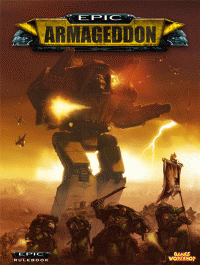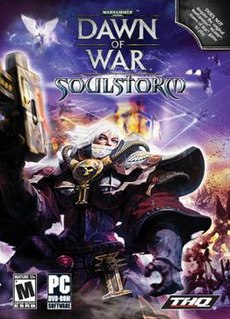
Warhammer 40,000 is a miniature wargame produced by Games Workshop. The first edition of the rulebook was published in September 1987. The latest edition is the eighth, which was published in June 2017. Warhammer 40,000 is the most popular miniature wargame in the world; it is most popular in Britain.
In the fictional setting of Warhammer 40,000, the Eldar are a race of aliens and playable army in the tabletop miniatures wargame. They are patterned after the High Elves of fantasy fiction; long-lived, arrogant, and possessing great psychic powers. The Eldar once ruled the galaxy and seek to reclaim their old dominions from humanity and the other Warhammer 40,000 races.
In the fictional universe of Warhammer 40,000, the Tyranids are a race and a playable army in the tabletop miniatures wargame.

Games Workshop Group PLC is a British manufacturer of miniature wargames, based in Nottingham, England. Its best-known products are Warhammer Age of Sigmar and Warhammer 40,000. It is listed on the London Stock Exchange and is a constituent of the FTSE 250 Index.

Epic is a tabletop wargame set in the fictional Warhammer 40,000 universe. Whereas Warhammer 40,000 involves small battles between forces of a few squads of troops and two or three vehicles, Epic features battles between armies consisting of dozens of tanks and hundreds of soldiers. Due to the comparatively larger size of the battles, Epic miniatures are smaller than those in Warhammer 40,000, with a typical human being represented with a 6mm high figure, as opposed to the 28mm minis used in Warhammer 40,000.

In the fictional universe of Warhammer 40,000, the Orks are a race of aliens and a playable army in the tabletop miniatures wargame. Alongside the Space Marines, Orks are one of the most iconic elements of the Warhammer 40,000 universe.
The Old Ones are a mythical and mysterious race or possibly a group of distinct species in the table-top wargame Warhammer 40,000. They played a pivotal role in the history of many races, including the Eldar, Jokaero, Humans, Orks and Necrons.
Battle for Armageddon is a strategic boardgame produced by Games Workshop. Unlike the many Games Workshop games that use miniatures, this is a more traditional counter and board game.
Inquisitor was a tabletop miniatures game based in Games Workshop's Warhammer 40,000 universe. Whereas the main line of Warhammer 40K games is based on squad based tactical warfare, Inquisitor focused on a small group of player characters akin to many role-playing games. Inquisitor miniatures are no longer produced by Games Workshop but, whilst they were, the game had its own website and 54 mm scale models were available as "Specialist Games" from the Games Workshop catalogue.
In the fictional universe of Warhammer 40,000, psykers are individuals that can easily be confused with, and be described similarly as individuals with some form of psychic ability. They draw their power from the Warp, a different dimension often used for FTL similar to, but not quite the same as either Hyperspace or slip space, having both a different set of laws and form of energy, and can use this as either energy for a variety of effects or access to a different set of laws not of typical governance, or both, such as reading minds, foretelling the future, healing injuries, or incinerating foes. Because the Warp is inhabited by entities interpreted as daemons, all psykers are at constant risk of being tapped into and their powers used by others, not to be confused with possession although possible too, which is done through certain methods often time requiring sacrifices to open a portal, rather than psykers.

Warhammer 40,000: Dawn of War – Winter Assault is the first expansion to Warhammer 40,000: Dawn of War for the PC developed by Relic Entertainment and published by THQ. Based on Games Workshop's tabletop wargame, Warhammer 40,000, Dawn of War: Winter Assault was released on September 23, 2005. Some time after its initial release, Winter Assault and Dawn of War were coupled together in a double pack which featured some art on a fold out cover, an Ork with a flamethrower, or a group of Imperial Guard tanks lined up for attack. Though Winter Assault required the base game to play, its follow-up expansions, Dawn of War: Dark Crusade and Dawn of War: Soulstorm were stand-alone, not requiring the base game.

Warhammer 40,000: Rogue Trader is the first edition rule/source book for the Warhammer 40,000 miniature wargame by Games Workshop. The subtitle refers to a particular class of character within the Warhammer 40,000 universe.

Warhammer 40,000: Rites of War is a turn-based strategy game based on the Panzer General 2 engine by SSI. It is set in the fictional Warhammer 40,000 universe. It was produced by Games Workshop in 1999, and concerns the invasion of a Tyranid Hive fleet and the Eldar and Imperial efforts to defeat it. The game was re-released in 2015 on GOG.com.

The T'au Empire is a fictional alien empire that appears in the setting of Warhammer 40,000. Warhammer 40,000 is a miniature wargame, and the Tau are one of the playable armies in the game.
Armies of Warhammer are components of the table-top games Warhammer Fantasy Battle, Warhammer Age of Sigmar, and Warhammer 40,000. The armies have been defined into a separate "army list," and they are described in more detail in the Warhammer Army Book, Age of Sigmar Battletome, or Warhammer 40,000 Codex. Players of either game, or their spin-offs, have a wide variety of army choices and each army can be customised to suit a particular playing style. All games are produced by Games Workshop.

Warhammer 40,000: Dawn of War – Soulstorm is the third expansion to the real-time strategy video game Warhammer 40,000: Dawn of War, developed by Iron Lore Entertainment. Like its predecessors, Soulstorm is based on Games Workshop's tabletop wargame Warhammer 40,000, and introduces a multitude of new features to the Dawn of War series, including two new playable factions in the form of the Imperial Sisters of Battle and the Dark Eldar. It is a stand-alone game and does not need the original Dawn of War disc to run, but players must have the prior games installed and valid cd-keys in order to play as anything but the two new factions online.
Warhammer 40,000 Collectible Card Game, sometimes denoted WH40KCCG is an out-of-print collectible card game released in 2001 by Sabertooth Games. It is set in the fictional Warhammer 40,000 universe. The players may select various factions around which they could base their personalized deck. These factions include Orks, Space Marines, Chaos, Eldar, Tyranids, Imperial Guard, and Dark Eldar; there were also sub-factions.

Warhammer 40,000: Dawn of War II is a real-time strategy-tactical role-playing video game developed by Relic Entertainment and published by THQ for Microsoft Windows based on the fictional Warhammer 40,000 universe. It is the sequel to the Warhammer 40,000: Dawn of War video game series. Dawn of War II was released in North America on February 19, 2009 and in Europe on February 20, 2009. A sequel, Dawn of War III, was released in April 2017.

Warhammer 40,000: Dawn of War II – Retribution is the stand-alone second expansion to Warhammer 40,000: Dawn of War II, part of the Warhammer 40,000: Dawn of War series of real-time strategy video games. Set in Games Workshop's Warhammer 40,000 fictional universe, the single player campaign is playable with multiple races.

Warhammer 40,000: Conquest was a Living Card Game (LCG) produced by Fantasy Flight Games, set in Games Workshop's Warhammer 40,000 universe. It was announced in March 2014 and was released October 3, 2014. The game featured two players competing to win a series of battles on a different planets while simultaneously securing the resources of other planets that will have battles on subsequent turns. Fans of the game praised the strategic element of having multiple distinct battle fields as a feature that distinguished it from other card games. On September 9, 2016, Games Workshop announced that Conquest would be discontinued in February 2017, as a result of Games Workshop's failure to renew Fantasy Flight Games' contract because of a conflict between Games Workshop and Fantasy Flight Games' parent company, Asmodee. The game still has a small community of players who play with the cards that were printed before the game's discontinuation in 2017, and some fans have made unofficial expansions to expand the small card pool.











